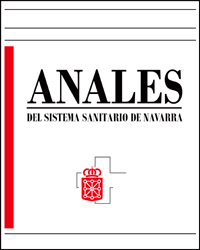Juzgados y documentación clínica
Palabras clave:
Documentación clínica. Acceso legal. Administración de justicia.Resumen
Fundamento. Hasta el año 2004 las solicitudes de documentación clínica por parte de la Administración de Justicia sobre Asistencia Especializada de Pamplona se recibían en seis centros distintos, siendo tramitadas de manera independiente, con maneras de proceder diferentes e incluso con envío de documentación duplicada, con la consiguiente carga de trabajo. En el presente trabajo se describe el procedimiento para la tramitación de solicitudes de documentación remitidas desde los juzgados y analizar las solicitudes recibidas. Material y métodos. Se estableció un circuito para canalizar las solicitudes judiciales que llegaban a los centros de Asistencia Especializada de Pamplona y al Servicio de Régimen Jurídico del Servicio Navarro de Salud-Osasunbidea y se contrató un Técnico Superior en Documentación Sanitaria que las centralizara. Se elaboró un protocolo de actuación para unificar criterios y agilizar el proceso, y se diseñó una base de datos para registrar las actuaciones. Resultados. Durante el año 2004 se recibieron 210 solicitudes de documentación por exigencia legal. De éstas, 24 fueron por reclamaciones de responsabilidad patrimonial y 13 fueron solicitadas por abogados con autorización del paciente. El orden jurisdiccional más frecuente fue el penal (43,33%). El 93,15% de las solicitudes provenían de juzgados de la propia comunidad. El centro que mayor número de solicitudes recibió fue el Centro de Consultas “Príncipe de Viana” (33,73%). La documentación solicitada más frecuente fue la copia de informes (109) y la copia de historia completa (39). En dos ocasiones se requirió historia original. El tiempo medio de respuesta fue de 6,6 días. Conclusiones. La centralización de la gestión ha aportado mayor agilidad al proceso y homogeneidad en los criterios de actuación. Conlleva menos tiempo en la preparación y envío de la documentación, evita el envío de documentación duplicada, disminuye la carga de trabajo y evita la dispersión de la documentación, situación que garantiza una mayor intimidad para el paciente.Descargas
Descargas
Publicado
Cómo citar
Número
Sección
Licencia
La revista Anales del Sistema Sanitario de Navarra es publicada por el Departamento de Salud del Gobierno de Navarra (España), quien conserva los derechos patrimoniales (copyright ) sobre el artículo publicado y favorece y permite la difusión del mismo bajo licencia Creative Commons Reconocimiento-CompartirIgual 4.0 Internacional (CC BY-SA 4.0). Esta licencia permite copiar, usar, difundir, transmitir y exponer públicamente el artículo, siempre que siempre que se cite la autoría y la publicación inicial en Anales del Sistema Sanitario de Navarra, y se distinga la existencia de esta licencia de uso.








